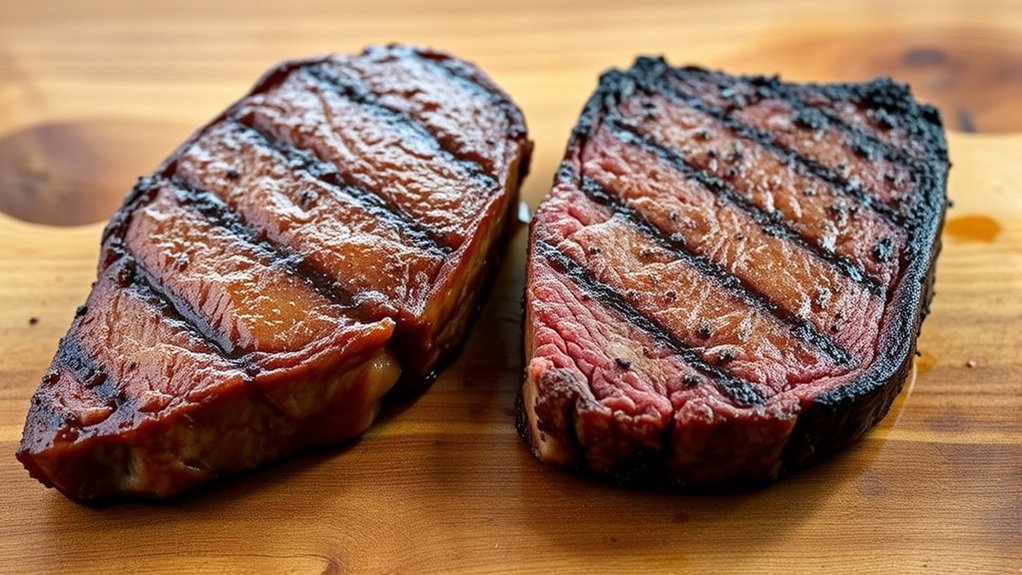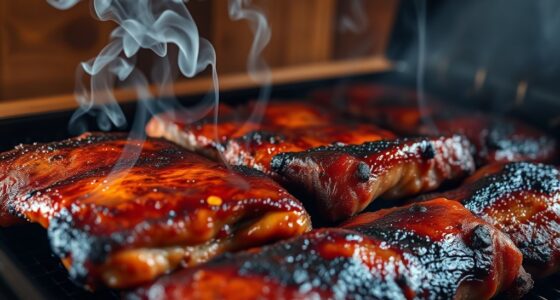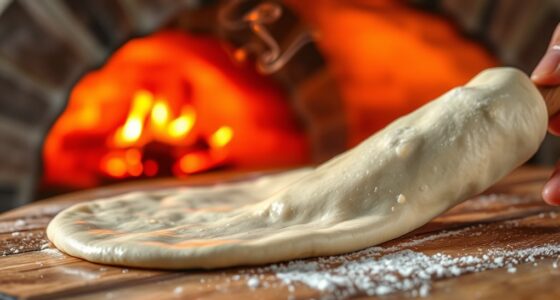If you want more evenly cooked steaks with a perfectly developed crust, the reverse sear method is often better. It starts with a gentle, low-temperature cook, giving you better control over internal doneness and reducing the risk of overcooking. Then, a quick high-heat sear creates a flavorful crust. Traditional sear and finish can give a more pronounced crust but risks uneven cooking. To discover which approach suits your preferences, keep exploring the details.
Key Takeaways
- Reverse sear offers more even interior doneness and precise temperature control before searing, reducing overcooking risk.
- Traditional sear and finish creates a more pronounced crust quickly but may lead to uneven cooking if not monitored carefully.
- Reverse sear produces a consistent, deeply caramelized crust with less chance of burnt exterior.
- Sear and finish is simpler and faster, ideal for a quick, flavorful crust but may compromise interior uniformity.
- Choice depends on preference for crust intensity versus interior evenness; both techniques can yield excellent results with proper technique.

When it comes to achieving perfectly cooked steaks, chefs often debate between the reverse sear and the traditional sear-and-finish methods. Both techniques are effective, but they differ markedly in how you approach cooking techniques and flavor development. Understanding these differences helps you decide which method aligns best with your preferences and cooking style.
With the traditional sear-and-finish method, you start by cooking the steak at a lower temperature, typically in the oven or on a grill, then finishing with a high-heat sear in a skillet or on a grill. This approach allows for gradual heat penetration, giving you more control over the internal doneness. The initial slow cook ensures the meat is evenly warmed through, reducing the risk of overcooking the exterior. When you finish with a sear, the high heat creates a flavorful crust through the Maillard reaction, which is essential for rich flavor development. This crust is where most of the taste and aroma are concentrated, giving your steak that irresistible char and depth.
Starting with low heat and finishing with high sear creates a flavorful crust and precise doneness control.
On the other hand, the reverse sear flips this process. You start by slowly cooking the steak at a low temperature, either in the oven or sous-vide, until it reaches just below your desired doneness. Then, you finish with a quick, intense sear. This method emphasizes precise control over the internal temperature before adding the crust, reducing the chances of overcooking. When it comes to flavor development, the reverse sear produces a more evenly cooked interior with a beautifully caramelized crust. Since the steak is cooked gently first, the final sear enhances flavor without risking a burnt exterior or undercooked center. The result is a steak with a consistent doneness and a deep, rich crust that’s hard to beat.
Both techniques influence flavor development differently. The traditional method often results in a more pronounced crust because of the high initial heat, but it can sometimes lead to uneven cooking if not carefully managed. Meanwhile, the reverse sear offers a more uniform interior and a well-developed crust, thanks to the controlled initial cooking. Your choice depends on whether you prioritize a traditional, hearty crust or a perfectly even doneness with a refined crust. Additionally, proper equipment such as a reliable oven or sous-vide device can make a significant difference in achieving optimal results. Whichever method you choose, mastering these cooking techniques will elevate your steak game and ensure a delicious, flavorful bite every time.
Frequently Asked Questions
Which Method Is Faster for Cooking a Steak?
The sear and finish method is faster for cooking a steak because it involves quick high-heat searing followed by a short rest, reducing overall cooking time. This method minimizes preparation time since you skip the slow pre-cooking process involved in reverse searing. If you’re pressed for time, searing and finishing will get your steak ready quicker, allowing you to enjoy a perfectly cooked meal without lengthy prep.
Can Reverse Sear Be Used on All Types of Meat?
Did you know that reverse searing works well with over 90% of thick cuts of meat? You can definitely use reverse sear for various meats, thanks to its cooking versatility. It enhances flavor and creates a more even doneness. Whether you’re cooking beef, pork, or even thicker cuts of poultry, reverse sear offers excellent control and flavor enhancement, making it a reliable method across different types of meat.
How Does Resting Time Differ Between Methods?
You’ll notice resting time differs between methods because reverse searing usually requires longer resting for temperature stability and resting consistency. After reverse searing, you tend to rest the meat longer to allow even heat distribution and juices to settle. With the traditional sear and finish, resting is typically shorter, as the meat cools and stabilizes quickly. Overall, the reverse method emphasizes a more controlled, longer resting period for better results.
Is One Method Better for Thick Cuts?
For thick cuts, the reverse sear method often outperforms sear and finish, as it cooks evenly and results in a perfect crust. Studies show that reverse searing can improve internal temperature consistency by up to 15%. You’ll find it’s especially beneficial for thick cuts, providing a more uniform cook and better control over doneness. So, if you’re aiming for a tender, evenly cooked steak, reverse sear is generally the better choice.
Which Technique Produces a More Consistent Doneness?
You’ll find that the reverse sear technique produces more consistent doneness because it allows you to control cooking precision better. By slowly warming the meat first, you minimize temperature fluctuations, ensuring even doneness throughout. Plus, this method enhances flavor development, giving your meat a richer, more uniform taste. With reverse searing, you get reliable results and better flavor, making it ideal if consistency matters most to you.
Conclusion
Whether you choose the reverse sear or the traditional sear and finish, remember that both methods aim to deliver a perfect, juicy steak. If you’re worried about complexity, don’t be—practice makes perfect, and the result is worth it. Don’t let fear hold you back from impressing yourself and others with restaurant-quality meat at home. Trust your instincts, experiment a little, and enjoy the delicious journey of mastering your favorite cooking technique.









